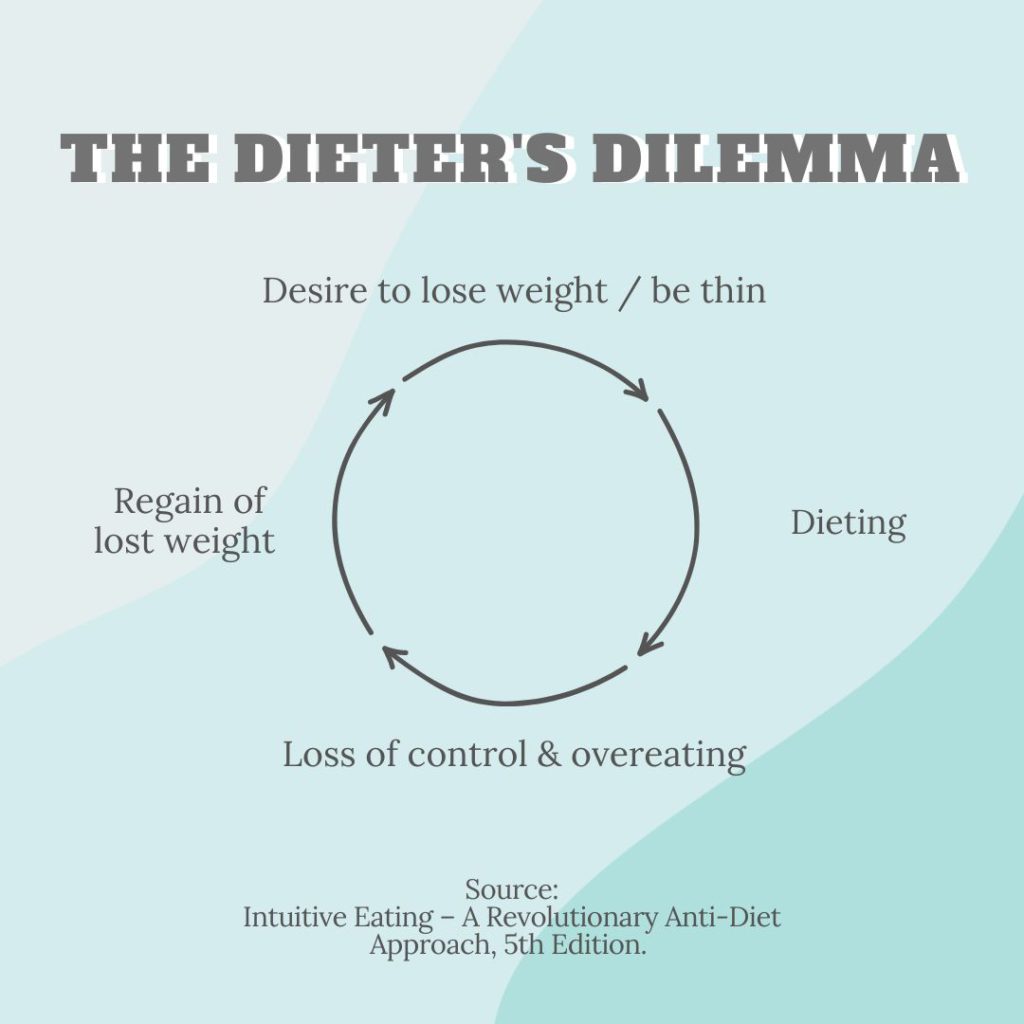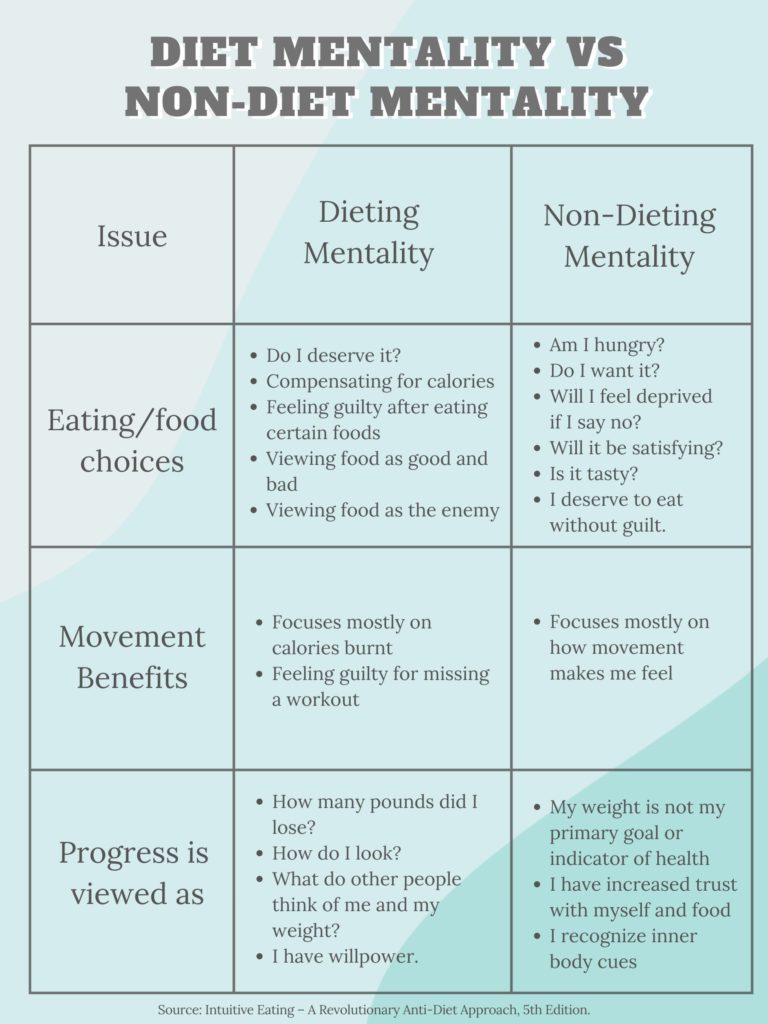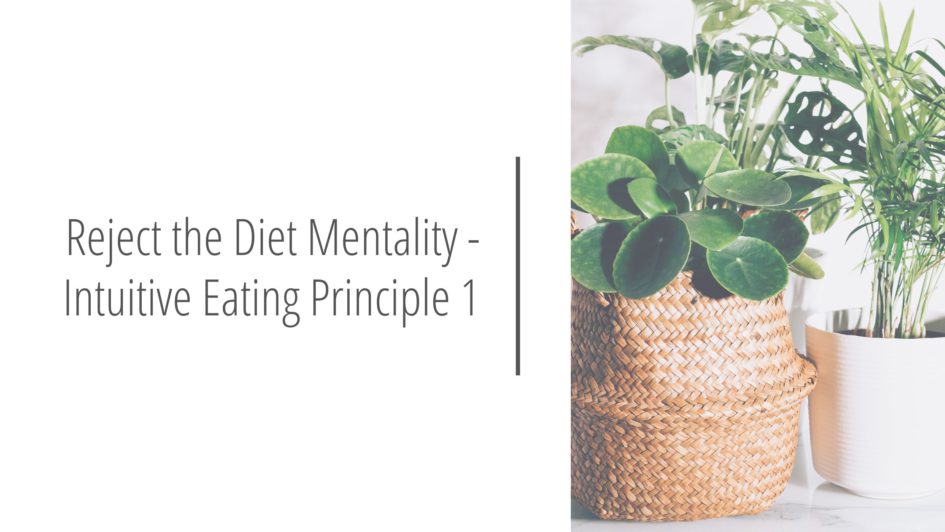Table of Contents
Reject the Diet Mentality
Do you feel like you are stuck in a dieting rut? Are you hopping from diet to diet to diet? Do you feel like each new diet you try leaves you wanting more? Maybe you have tried every diet under the sun but haven’t experienced long-term results. If this sounds like you, it might be time to reject the diet mentality.
Learning how to reject the diet mentality is a crucial first step in understanding and applying Intuitive Eating. To help you make this first leap, I have digested the plethora of information provided in Intuitive Eating – A Revolutionary Anti-Diet Approach, 4th Edition.
In this article, I hope to give a bite-size, tangible summary of this information and help you master Intuitive Eating Principle 1 – Reject the Diet Mentality. Let’s start with understanding the Dieter’s Dilemma.
The Dieter’s Dilemma
Odds are, if you are reading this, you have personally experienced the dieter’s dilemma. It is a vicious cycle of feeling the desire to lose weight ➡️ starting a diet ➡️ losing control over the diet ➡️ regaining lost weight ➡️ repeat ➡️repeat ➡️repeat. I’ve been there and it’s not a fun place to be.
In order to break the hold of the dieter’s dilemma, you have to let go of dieting and, you guessed it, reject the diet mentality.

Life Without Dieting
Releasing Control
For many of us, dieting has been a major part of our world for years. Dieting might even be ingrained in our identity. The thought of leaving dieting behind might sound scary. What does life without dieting even look like?
Dieting can be viewed as a comfort zone, a security blanket. It’s that one thing many of us turn to when we feel like we’re losing control over our lives. Dieting serves as a tool for control when life feels uncertain.
If you think about it, dieting is what people tend to turn to during life changes. Getting married? Diet. Leaving home for the first time? Diet. Starting a new job? Diet. Going through a divorce or relationship change? Diet. Transitioning from high school to college? Diet. Finding yourself? Diet. Life feels like it’s spiraling out of control? Diet.
Can you see the trend?
Fear VS Reality
The sense of control that dieting provides makes it scary to leave it in the past. However, the feeling of losing control isn’t the only thing holding people back from rejecting the diet mentality.
Here are some common fears experienced when leaving the diet train.
Fear
If I quit dieting, I won’t know when to stop eating and/or will feel out of control around food.
Reality
Dieting is actually one of the most common triggers for overeating. The undernourishment and deprivation that occurs with dieting often lead to binging and/or “cheat days.” This is because the body doesn’t know the difference between dieting and starvation. Once you stop dieting, the body will eventually learn and trust that food is coming and starvation isn’t a threat. When this trust is established, the drive for overeating or binging will diminish.
Fear
If I quit dieting, I won’t know how to eat properly without a plan to follow.
Reality
Dieting is rigid and goes against the body’s natural cues. Once you become a seasoned Intuitive Eater, knowing when and what to eat will become second nature. You won’t need a plan to follow.
Ask Yourself: Have I Really Left Dieting in the Past?
Pseudo-Dieting – What is it?
Even with the best intentions, it’s easy to slip back into the diet mentality with or without realizing it. Tribole & Resch, the authors of Intuitive Eating, refer to this as pseudo-dieting or unconscious dieting. It’s when someone thinks they have given up the diet mentality but in actuality, the food-restrictive thoughts are still there. Pseudo-dieting behaviors are not typically noticeable to the person experiencing them.
Examples of Pseudo-Dieting
Macro-counting
The modern version of counting calories. While there might be good intent in keeping track of nutrient intake, meticulously counting things like carbohydrates (unless you are a diabetic) can be problematic. It keeps a person in a mindset of rationing regardless of bodily needs, which does not align with Intuitive Eating.
Safe Foods
Sticking to only eating foods that have been deemed “safe.” This could be food that an individual personally deemed safe, a wellness influencer, a diet plan, a mother figure, and/or friends deemed “safe” aka healthy. This typically looks like (but is not limited not) only eating foods that are low-calorie, fat-free, gluten-free, sugar-free, etc.
Eating Only at Designated Times
Examples include (but are not limited to) fasting in the morning until lunchtime or not eating after 6 pm, regardless of hunger levels. These times have been arbitrarily set and do not need to be followed. As Tribole and Resch wrote, “Our bodies do not punch time clocks.” Just because we think we shouldn’t be hungry or shouldn’t eat yet or shouldn’t eat at a specific time, does not mean that our bodies agree. Additionally, this goes against the very backbone of Intuitive Eating, which is listening to your hunger and fullness cues.
Compensating for Eating “Bad Foods”
Compensating for eating certain foods could look like (but is not limited to) skipping meals, eating less even when you’re hungry for more, stating the diet starts morning, or intentionally burning more calories during exercise to make up for food intake.
Cutting Back on Food
Unconscious undereating often occurs (but is not limited to) when a special event, like a wedding or high school reunion, comes around. This can even occur when clothes feel like they fit tighter. But! Don’t forget, as mentioned earlier, undereating often leads to overeating.
Subueing Hunger with Coffee, Diet Soda, Gum, etc.
This is a common low-calorie “trick” to reduce hunger pain or an attempt to nip hunger in the bud without actually eating.
Limiting Carbs
Carbohydrates have such a bad reputation, even though they are vital for brain function and day-to-day energy levels.
Performative Eating
This is where an individual puts on an act in front of other people, eating only foods that meet the expectations of those around them. This often backfires once the individual is alone.
Dieting Competition
Since, according to society, a person that is dieting is often a “better person” than someone who is not, it’s easy to feel obligated to eat the same way as the “better person.”
“It’s a Lifestyle”
This is where an individual convinces themself they’re not following a diet but are pursuing a lifestyle change. While making lifestyle changes, such as eating more vegetables, are a great idea, things tend to quickly become restrictive and non-intuitive. This leads back to hopping from diet to diet, but under the disguise of a lifestyle change.
Rigid Healthy
Sometimes pursuing health too hard can backfire and become unhealthy. When this happens, it’s called Orthorexia Nervosa, a type of eating disorder where one is obsessed with healthy living.
Diet Mentality VS Non-Diet Mentality
This table is a great way to decipher the difference between diet mentality and non-diet mentality.

How to Reject the Diet Mentality
In order to reject the diet mentality, the brain has to go through a journey of reframing.
Step 1: Recognize the Damage Dieting Causes
As Tribole and Resch wrote, “Remember, if dieting is the problem, how can it be part of the solution?”
Biological Damage
- Decreases metabolism
- Increases risk of premature death and heart disease
- Dysfunctional satiety cues
- Headaches
- Irregular menstrual cycles
- Fatigue
- Dry skin
- Hair loss
Psychological & Emotional Damage
- Eating disorders
- Increases stress levels and vulnerability to stress
- Increases feelings of failure, social anxiety, and low self-esteem
- Sense of being out of control
- Decreased confidence and self-trust
Step 2: Be Aware of Diet Mentality Traits and Thinking
Forget Willpower
Willpower can be defined as “an attempt to counter natural desires and replace them with proscriptive rules.” Willpower does not belong in Intuitive Eating as it goes against the body’s natural cues.
Forget Obedience
Forget obeying the rules society and wellness culture have put into place. Rebel against those beliefs.
When practicing Intuitive Eating, there is no need to rebel against it, because you are finally the one in control.
Forget Failure
Intuitive Eating is not a diet. You cannot fail at Intuitive Eating. Instead, it is a non-linear, never-ending learning process.
Step 3: Get Rid of the Dieter’s Tools
Get. Rid. Of. That. Scale.
You read that right. Throw it out! It has no place in Intuitive Eating.
Quick Summary – Reject the Diet Mentality
Unlearning & Relearning
Rejecting the diet mentality does not happen overnight. Becoming an Intuitive Eater does not happen overnight. It takes unlearning and relearning, perseverance, patience, and the desire to change.
The Crucial Pieces
- Recognizing the dieter’s dilemma
- Releasing control
- Facing your fears
- Knowing how to identify pseudo-dieting
- Pointing out the differences between diet mentality and non-diet mentality
- Recognizing the damage dieting causes
- Getting rid of dieter’s tools, aka the scale
These are all crucial pieces in learning how to reject the diet mentality.
Dig Deeper
If you would like to dig deeper into Intuitive Eating, I recommend grabbing a copy of Intuitive Eating – A Revolutionary Anti-Diet Approach, 4th Edition by Evelyn Tribole and Elyse Resch. It can be found where books are sold, including Amazon. The official Intuitive Eating Website is also a great resource.
For additional reading, check out the Intuitive Eating section on my website. Whether you’re a newbie intuitive eater or a seasoned one, take a look at my anti-diet themed store for fun Intuitive Eating products!
Thanks for reading!
Rachel Beiler, MHS, RD, LDN
References
Intuitive Eating: A Revolutionary Anti-Diet Approach, 4th Edition by Evelyn Tribole & Elyse Resch


Leave a Reply